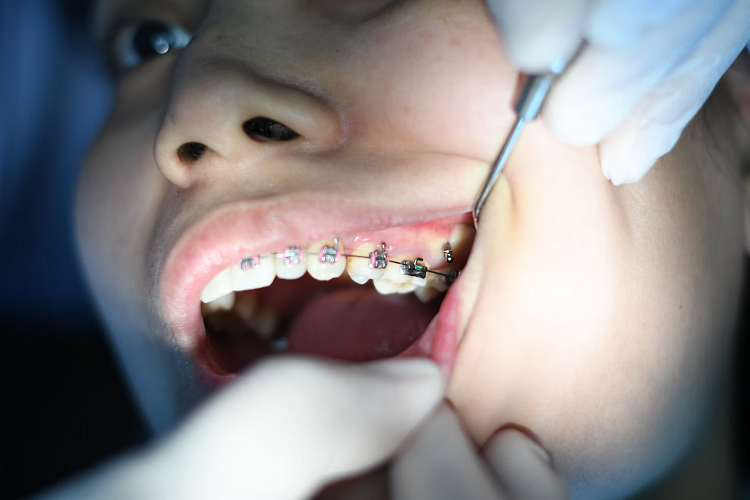How Braces Fix Your Teeth

Crooked teeth not only look bad, but can also create excess pressure on certain teeth that leads to issues chewing and speaking. Braces use constant pressure to gradually shift your jaws into healthier positions for easier chewing and speaking.
Braces not only combine stainless steel brackets, orthodontic bands and arch wires to help correct a variety of bite issues – but we can take a closer look at each component to better understand their functions and show why they can help your whole mouth sparkle.
Table of Contents
Brackets
Braces consist of metal wires and brackets bonded to the front of your teeth. An arch wire, also called an intraoral wire, is flexible at room temperature but becomes firmer once inside your mouth – an orthodontist will use this wire to apply consistent pressure over time to individual teeth to help them shift into their proper places more quickly.
Each bracket holds onto this arch wire via an elastic band called ligatures that help create pressure against each bracket by keeping its arch wire tight against it – the color helps add pressure.
Apart from providing pressure, ligatures also help guide teeth into their correct positions by guiding ligatures into place and guiding ligature springs into position until they’re ready to come off (https://www.colgate.com/en-us/oral-health/adult-orthodontics/what-are-elastics-for-braces) thus reducing friction between teeth that causes soreness or can even damage enamel and cause discoloration or cavities. Braces can alleviate these issues by relieving pressure from surrounding tissues as well.
You can keep your braces clean and in good working order by following these tips from orthodontists, including various cleaning techniques, foods to avoid and any loose brackets that come loose that should be reported immediately so the orthodontist can determine if repairs can be made or an emergency appointment must be scheduled.
Wires
Most braces work by applying constant pressure to teeth and jawlines, gradually shifting them into new positions. Treatment will vary for every individual; traditional wire braces consist of brackets and arch wires as the primary components, with brackets being the small squares attached directly to each tooth or sometimes to orthodontic bands that help secure them into place and apply steady pressure onto your jaw.
Metal spring arch wires are threaded through brackets and bent to meet each tooth, with their shape memory eventually returning back to their U-shape and taking the tooth with it. Although traditional wire braces are an effective method of straightening dentures or issues, they may sometimes cause discomfort and damage to teeth or gums if their arch wire management is improperly managed.
Unless your wire is poky enough for pain to become severe, orthodontists will often recommend using orthodontic wax to cover and cushion it until you can visit them for adjustments. This is also one way to protect yourself from mouth cuts due to sharp wires; its use should always be undertaken responsibly for maximum effectiveness and safety.
Maintaining a nutritious diet while wearing braces is also key to their effectiveness and could have an enormous impact on how long the braces need to remain on and their impact upon your smile after removal. Brushing twice daily and flossing once daily are both recommended to keep food debris and plaque at bay in your mouth and keep your mouth free of infection?
Bonding
Bonding is a quick and cost-effective solution that can quickly hide cosmetic flaws like chips, cracks and discolorations in teeth. A composite resin material is applied directly onto each individual tooth before being colored to look like natural enamel for an enhanced appearance.
This process usually takes 30 to 60 minutes per tooth. Your Dentist in Balwyn will begin by selecting the shade of composite resin that best matches the color of your tooth, before roughening up its surface and applying a liquid that helps bond the resin onto it. Finally, they will mold it onto the tooth using ultraviolet lights before making any necessary final adjustments before polishing for a natural-looking shine.
Teeth bonding may not last as long as porcelain veneers, and is more prone to chipping or staining over time. But with proper care it could last as long as a decade – such as brushing at least twice daily and flossing daily along with annual dental cleanings and refraining from habits like biting fingernails or chewing hard foods or objects.
Bonding can be used to close small gaps or make minor alterations to the shape and size of teeth. If you want a drastic transformation of your smile, veneers may be better options. Major decay or gum disease must first be treated prior to getting tooth bonding done.
Retainers
Your journey to a beautiful smile and proper alignment of your bite doesn’t typically end when your braces come off. At this important stage for many patients (children, adolescents and adults), your dental professional may recommend retainers as an aid in stabilizing the position of your teeth after your treatment is complete.
Retainers are made from plastic or clear acrylic and come in various shapes to fit the roof of your mouth, featuring wires designed to secure over your teeth to hold their shape in place. Your exact choice may depend on individual circumstances – however options include traditional removable plates and clear retainers as possible options.
After receiving treatment, it may also be beneficial to wear a permanent retainer to ensure your teeth stay in their new positions afterward. Failure to wear the retainer regularly or even occasionally can cause your teeth to slowly shift back toward their original positions (known as relapse), which your orthodontist can easily correct with a custom-fitted retainer that has been specially created just for you.
Your orthodontist can make a retainer that blends in seamlessly with the color of your gums called an esthetic composite that serves to prevent this from occurring, though this approach takes more time and often doesn’t offer as much correction as traditional wire retainers do. Failure to wear your retainer as instructed could cause teeth to shift back into their original positions, which makes wearing it regularly very important – in most cases your orthodontist will recommend that it is worn nightly even after treatment, has concluded.
Leave a reply
You must be logged in to post a comment.




















